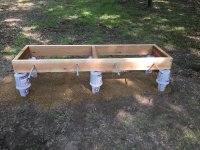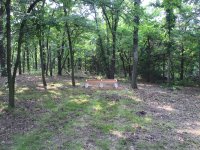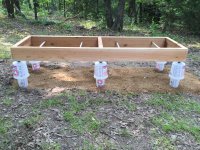- Messages
- 6,590
- Reaction score
- 3,279
- Points
- 422
- Location
- Lake Ray Roberts, Texas
- Boat Make
- Boatless
- Year
- NA
- Boat Model
- Other
- Boat Length
- NA
Ok, another adventure by txav8r! Tonight, we pick up two hives of bees! Yep, you read that right, HONEYBEES! We have been talking to those that keep them and reading/researching for the last month and a half. Today is the day! I figured that there were some here that may be beekeepers and offer a NOOB some pointers.
So what we have done, is to clear and mow our only spot that is suitable IMO. We have wooded acreage and I know they need at least morning sun to wake them and get them working. So we have an area the aerobic septic sprinklers have killed off the trees a little and caused grass and weeds to grow. I wanted to leave the flower and seed heads but figured I would have to cut and disturb the bees sooner or later, so I cut it. I adjusted the sprinkler heads to avoid the hives completely, but to water right up to either side of them. We installed a birdbath with rocks in it within twenty feet. I went overboard on the hive stand and ground under it (some would say typical of me). I dug out the existing heavily mulched forest floor and leveled it, then added about 3 inches of decomposed granite and leveled that. For a stand, we were going simple and then I just had to make it better. So I ditched the pallets and cinderblocks, and opted for building a better stand that would last and be more manageable. So I built a stand that would support up to 4 hives but we only have two coming for now. I had read about ants getting into the hives and causing them to abscond, so I changed my plans again. I added 12" threaded on both ends, galvanized steel pipe, and threaded a flange on both ends. Those are my legs and I made up 6 of them. I fashioned a rough cedar 2x6 frame for the support and attached the legs on each end and in the middle. The reason for the steel legs was so I could put the feet of the legs in small plastic buckets for ant control. I have a slightly larger bucket that slides on the pipe above the one on the ground, to allow it to act as a debris and rain cover, think umbrella. We filled the small buckets under the feet with oil, as ants can't cross a moat like that. I also drilled the frame and installed smaller diameter pipe with caps on both ends for frame hangers on the back of the support frame.
I read that bees come in a package through the mail with a queen in a separate cage included, or in a "Nuc" (nucleus) of 5 frames in a box, that are already working. When I found a supplier locally, they didn't sell the packages or nucs, they just sold a deep hive body with 10 frames already working, so you get a head start and higher success rate. It also comes the the hive inner and outer cover as well as a bottom board. We opted for two so we can compare the progress, activity, and problems we will face. They should pollenate our property (and everyone elses too!). And if we are successful, insert lucky here, we should get at least 60 pounds of honey per year after they are established this season. We may be able to take a few jars this year, but we are told not to push it and leave a super on top for food for them to overwinter.
Just thought I would share the latest adventure and ask for your thoughts and suggestions!




So what we have done, is to clear and mow our only spot that is suitable IMO. We have wooded acreage and I know they need at least morning sun to wake them and get them working. So we have an area the aerobic septic sprinklers have killed off the trees a little and caused grass and weeds to grow. I wanted to leave the flower and seed heads but figured I would have to cut and disturb the bees sooner or later, so I cut it. I adjusted the sprinkler heads to avoid the hives completely, but to water right up to either side of them. We installed a birdbath with rocks in it within twenty feet. I went overboard on the hive stand and ground under it (some would say typical of me). I dug out the existing heavily mulched forest floor and leveled it, then added about 3 inches of decomposed granite and leveled that. For a stand, we were going simple and then I just had to make it better. So I ditched the pallets and cinderblocks, and opted for building a better stand that would last and be more manageable. So I built a stand that would support up to 4 hives but we only have two coming for now. I had read about ants getting into the hives and causing them to abscond, so I changed my plans again. I added 12" threaded on both ends, galvanized steel pipe, and threaded a flange on both ends. Those are my legs and I made up 6 of them. I fashioned a rough cedar 2x6 frame for the support and attached the legs on each end and in the middle. The reason for the steel legs was so I could put the feet of the legs in small plastic buckets for ant control. I have a slightly larger bucket that slides on the pipe above the one on the ground, to allow it to act as a debris and rain cover, think umbrella. We filled the small buckets under the feet with oil, as ants can't cross a moat like that. I also drilled the frame and installed smaller diameter pipe with caps on both ends for frame hangers on the back of the support frame.
I read that bees come in a package through the mail with a queen in a separate cage included, or in a "Nuc" (nucleus) of 5 frames in a box, that are already working. When I found a supplier locally, they didn't sell the packages or nucs, they just sold a deep hive body with 10 frames already working, so you get a head start and higher success rate. It also comes the the hive inner and outer cover as well as a bottom board. We opted for two so we can compare the progress, activity, and problems we will face. They should pollenate our property (and everyone elses too!). And if we are successful, insert lucky here, we should get at least 60 pounds of honey per year after they are established this season. We may be able to take a few jars this year, but we are told not to push it and leave a super on top for food for them to overwinter.
Just thought I would share the latest adventure and ask for your thoughts and suggestions!










